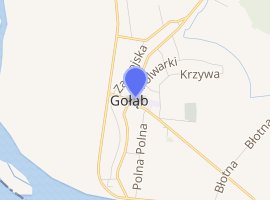Saints Catherine and Florian Church, Gołąb
Saints Catherine and Florian Church in Gołąb, Poland, is an early seventeenth-century church.
| Saints Catherine and Florian Church | |
|---|---|
| Kościół Wniebowzięcia Najświętszej Marii Panny, św. Floriana i św. Katarzyny w Gołębiu | |
 Saints Catherine and Florian Church | |

| |
| Location | Gołąb |
| Country | Poland |
| Denomination | Roman Catholic |
| History | |
| Founder(s) | Jerzy Ossoliński |
| Architecture | |
| Groundbreaking | 1626 |
| Completed | 1634 |
| Specifications | |
| Materials | Brick |
| Administration | |
| Parish | Parafia św. Floriana i św. Katarzyny w Gołębiu |
| Diocese | Roman Catholic Archdiocese of Lublin |
The church was founded by Chancellor Jerzy Ossoliński (1595-1650). Built between 1626-1634, the build was consecrated upon completion in 1634. The church's construction was influenced by different architectural movements which entered the Lublin Land (Lubelszczyzna) in the seventeenth century.[1]
Structure
It is difficult to categorise the architectural style of the church. The church's construction was influenced by Italian and Netherlandish architectural movements. Furthermore, the church's construction was strongly influenced by church construction in Kazimierz Dolny (most importantly, the Church of St. John the Baptist and St. Bartholomew, and the townhouses). It is likely that Kazimierz Dolny brick-layers worked on the church. From one side, the church building exhibits Italian architectural movements, whilst from the other, it has a Netherlandish Mannerist architectural style.[2]
The church is orientated, has one nave with four spans. From the east, it is closed-off by a narrowing corpus-nave presbytery in the shape of a half-rounded apse with two scarps. From the west, the façade is crowned with two towers. Between the two towers, the main nave has an attic gable. The church was built using Gothic brick in Polish brickwork.
The church's architectural style is characterised by the linkage of red-bricked walls with a bright, smooth architectural design. The brick elevation contrast ideally with the light-coloured plaster and sandstone architectural feature. The architectural feature has been richly detailed with sculpture, including the: lintel, window and portal frames, pilaster bases and capitals, cornices, and friezes. Furthermore, some of the blind windows, window niches, sacristy, and scarps are plastered.[3]
References
- Gołąb, Parafia. "Parafia i kościół parafialny – Parafia Gołąb". Parafia Gołąb (in Polish). Retrieved 10 March 2019.
- Miłobędzki, Adam (1980). Architektura polska XVII wieku (in Polish). Warsaw: Państwowe Wydawn. Naukowe. p. 300. ISBN 9788301013639. Retrieved 10 March 2019.
- Stankiewicz, Aleksander (2018). "Architektura kościoła parafialnego w Gołębiu. Przyczynek do badań wpływu projektów Ottaviana Mascarina na architekturę polską pierwszej połowy wieku XVII, "Roczniki humanistyczne KUL", 66 (2018), z. 4, s. 1-27". 4. 66: 1–27. Retrieved 10 March 2019.